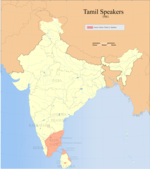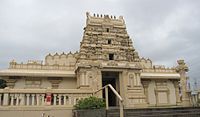Tamil Australians
| Total population | |
|---|---|
| 150,000 (2023) | |
| Regions with significant populations | |
Indian Tamils |
| Part of a series on |
| Tamils |
|---|
 |
|
Tamil portal |
Tamil Australians refers to
Demographics


The Census 2021 has found 95,404 people speaking Tamil at home. The total number of ethnic Tamils could be around 150,000 people well above the census data considering the possibility of refugee statuses being getting considered as Migrants as per refugee policy reform.[citation needed] This is the first time Indian Tamils have taken over as the majority over the Sri Lankan Tamils in a foreign country other than the United States. There are no exact figures for the number of Tamil Australians but according to the 2011 census there were 50,151 Australians, 0.23% of the population, who spoke Tamil at home.[2] Tamil speaking Australians are of Indian, Sri Lankan, Singaporean and Malaysian ancestry.[1] The Census 2016 shows an increase of 50% in Tamil population who speak Tamil at home.
There were 73,161 Tamil speakers according to the 2016 Census, with the largest proportion of people across Australia in the suburb of Westmead (1,425 people, or 3.6% of people in that suburb), followed by Toongabbie (NSW) (1,404 people, or 3.5% of people in that suburb).[3]
| Ancestry | Language (first ancestry) | Language (second ancestry) | ||||||||||
|---|---|---|---|---|---|---|---|---|---|---|---|---|
| Tamil | English | Sinhala | Not stated |
Other | Total | Tamil | English | Sinhala | Not stated |
Other | Total | |
Tamil |
11,407 | 1,057 | 85 | 58 | 149 | 12,756 | 650 | 257 | 16 | 13 | 48 | 984 |
| Indian Tamil | 406 | 50 | 4 | 3 | 15 | 478 | 21 | 12 | 0 | 0 | −1 | 32 |
Sri Lankan Tamil |
4,153 | 702 | 102 | 27 | 41 | 5,025 | 62 | 83 | 6 | 0 | 8 | 159 |
| Sub-total Tamil | 15,966 | 1,809 | 191 | 88 | 205 | 18,259 | 733 | 352 | 22 | 13 | 55 | 1,175 |
| Indian | 20,923 | 77,033 | 64 | 3,204 | 249,641 | 350,865 | 540 | 31,992 | 38 | 217 | 7,246 | 40,033 |
| Sri Lankan | 8,534 | 23,792 | 27,862 | 442 | 1,551 | 62,181 | 300 | 11,541 | 679 | 47 | 389 | 12,956 |
| Australian | 748 | 4,777,283 | 684 | 24,942 | 118,275 | 4,921,932 | 82 | 2,135,198 | 50 | 6,458 | 34,761 | 2,176,549 |
| Sinhalese | 942 | 2,351 | 16,898 | 115 | 225 | 20,531 | 76 | 901 | 1,372 | 13 | 54 | 2,416 |
| English | 862 | 7,062,120 | 809 | 33,676 | 125,990 | 7,223,457 | 7 | 13,136 | 8 | 107 | 1,821 | 15,079 |
| Malay | 502 | 6,973 | 17 | 134 | 13,230 | 20,856 | 91 | 9,015 | 32 | 56 | 3,568 | 12,762 |
| Singaporean | 178 | 1,930 | 0 | 123 | 1,302 | 3,533 | 25 | 2,083 | 0 | 13 | 498 | 2,619 |
| Not stated | 856 | 391,451 | 913 | 979,843 | 102,167 | 1,475,230 | 47,984 | 10,434,941 | 45,710 | 1,060,759 | 3,465,645 | 15,055,039 |
| Other | 640 | 4,164,549 | 754 | 42,924 | 3,202,008 | 7,410,875 | 313 | 3,870,132 | 281 | 17,808 | 300,557 | 4,189,091 |
| Total | 50,151 | 16,509,291 | 48,192 | 1,085,491 | 3,814,594 | 21,507,719 | 50,151 | 16,509,291 | 48,192 | 1,085,491 | 3,814,594 | 21,507,719 |
As per the 2011 census, over 39.59% of Tamil speaking Australians were born in Sri Lanka, 34.89% in India and 13.05% in Australia.[1]
| Country | Population | % |
|---|---|---|
| Sri Lanka | 19,855 | 39.59% |
| India | 17,500 | 34.89% |
| Australia | 6,547 | 13.05% |
| Malaysia | 2,782 | 5.55% |
| Singapore | 1,687 | 3.36% |
| Not stated | 445 | 0.89% |
| Other | 1,335 | 2.66% |
| Total | 50,151 | 100.00% |
They live concentrated in
| State suburb |
State | Tamils | % of suburb |
% of Tamils |
|---|---|---|---|---|
| Wentworthville[4] | NSW | 1,073 | 10.13% | 2.14% |
| Glen Waverley[5] | VIC |
945 | 2.41% | 1.88% |
| Dandenong[6] | VIC |
935 | 3.75% | 1.86% |
| Westmead[7] | NSW | 908 | 6.41% | 1.81% |
Toongabbie[8] |
NSW | 853 | 6.56% | 1.70% |
| Pendle Hill[9] | NSW | 849 | 12.74% | 1.69% |
| Strathfield[10] | NSW | 815 | 3.45% | 1.63% |
| Girraween[11] | NSW | 760 | 16.19% | 1.52% |
| Auburn[12] | NSW | 659 | 1.99% | 1.31% |
Lidcombe[13] |
NSW | 658 | 3.95% | 1.31% |
| Seven Hills[14] | NSW | 650 | 3.45% | 1.30% |
| Homebush[15] | NSW | 588 | 9.49% | 1.17% |
| Dandenong North[16] | VIC |
531 | 2.42% | 1.06% |
More than 80% have completed high school education; the rate is only 50% for the general Australian population.[2] More than 59% own their houses, compared with more than 67% of the general population.[2]
Tamil Australians
- Christie Jayaratnam Eliezer, emeritus professor
- Geraldine Viswanathan, actress
- Nazeem Hussain, comedian
- Clarence Jey, record producer
- Suresh Joachim, multiple Guinness World Record holder
- Kamahl, singer
- Palani O. Thevar, Politician, social worker, Labor candidate for Maiwar in the 2020 Queensland state election [1]
- Kumar Mahadevan, Michelin star chef
- Jega Nadarajah, Olympic Torch Bearer 2000 Olympics
- Samantha Ratnam, Politician, social worker, current leader of the Victorian Greens
- Duvashen Padayachee, race driver
- Guy Sebastian, singer and winner of the first season of Australian Idol; of partial Malaysian Tamil descent
- Prashanth Sellathurai, gymnast
- Maha Sinnathamby, entrepreneur[17]
- Renuga Veeran, badminton player
- Jonathan Sriranganathan, Councillor for The Gabba Ward in the Brisbane City Council
- Ecca Vandal, Singer-songwriter
- Vimala Raman, actress
- Dhee, Singer
- Prof Rama Jayaraj, Darwin
- Nivethan Radhakrishnan, Cricketer
References
- ^ a b c d "2011 Census of Population and Housing". Table Builder. Australian Bureau of Statistics.
- ^ a b c d "Census Explorer". Special Broadcasting Service.
- ^ "ஆஸ்திரேலியாவின் எந்த suburb-இல் தமிழர்கள் அதிகமாக வாழ்கின்றனர்? | SBS Your Language". www.sbs.com.au. Archived from the original on 9 August 2017.
- ^ "Wentworthville Code SSC12459 (SSC)". Quick Stats. Australian Bureau of Statistics.
- ^ "Glen Waverley Code SSC20535 (SSC)". Quick Stats. Australian Bureau of Statistics.
- ^ "Dandenong Code SSC20366 (SSC)". Quick Stats. Australian Bureau of Statistics.
- ^ "Westmead Code SSC12484 (SSC)". Quick Stats. Australian Bureau of Statistics.
- ^ "Toongabbie (NSW) Code SSC12293 (SSC)". Quick Stats. Australian Bureau of Statistics.
- ^ "Pendle Hill Code SSC11859 (SSC)". Quick Stats. Australian Bureau of Statistics.
- ^ "Strathfield (NSW) Code SSC12164 (SSC)". Quick Stats. Australian Bureau of Statistics.
- ^ "Girraween (NSW) Code SSC10950 (SSC)". Quick Stats. Australian Bureau of Statistics.
- ^ "Auburn (NSW) Code SSC10070 (SSC)". Quick Stats. Australian Bureau of Statistics.
- ^ "Lidcombe Code SSC11363 (SSC)". Quick Stats. Australian Bureau of Statistics.
- ^ "Seven Hills (NSW) Code SSC12064 (SSC)". Quick Stats. Australian Bureau of Statistics.
- ^ "Homebush (NSW) Code SSC11125 (SSC)". Quick Stats. Australian Bureau of Statistics.
- ^ "Dandenong North Code SSC20367 (SSC)". Quick Stats. Australian Bureau of Statistics.
- ^ "Maha Sinnathamby - Greater Springfield". Greater Springfield. Retrieved 16 April 2018.
External links
- Australia Tamil Association
- Australian Tamil Congress
- Australia Tamil Matrimonial Services
- Tamilians Traditional Sarees
- ^ According to the local classification, South Caucasian peoples (Azerbaijanis, Armenians, Georgians) belong not to the European but to the "Central Asian" group, despite the fact that the territory of Transcaucasia has nothing to do with Central Asia and geographically belongs mostly to Western Asia.

